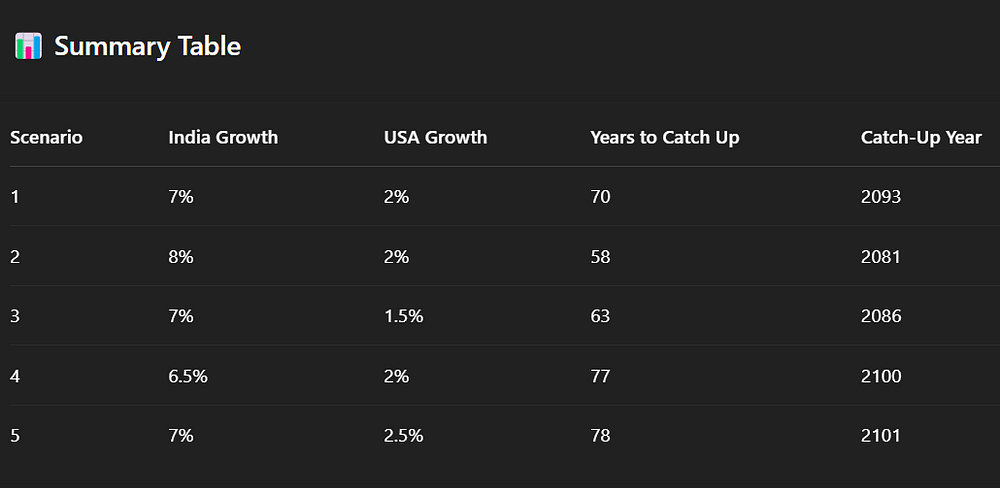🧮 When Will India’s Per Capita GDP Catch Up to the USA? A Data-Driven Look at 5 Scenarios
A Data-Driven Look at 5 Scenarios
India’s economic story is remarkable. As one of the fastest-growing major economies, people often ask:
“When will India’s per capita income catch up to that of the United States?”
It’s a meaningful question — not just about raw GDP but about economic prosperity per person.
Let’s break this down — using real math and multiple realistic scenarios.
🇮🇳 vs 🇺🇸: Where We Stand Today
As of 2023:
- India’s per capita GDP: ~$2,500
- USA’s per capita GDP: ~$70,000
- Income gap (USA / India): 28x
If both countries grow at the same rate, India will never catch up. So, the key is India growing faster — which has been true historically.
📐 The Math of Catching Up
We model this using compound growth for both countries:
Let:
- P_I0 = current per capita GDP of India = 2,500
- P_U0 = current per capita GDP of USA = 70,000
- g_I = India’s annual per capita GDP growth rate
- g_U = USA’s annual per capita GDP growth rate
- t = number of years it takes to catch up
The future per capita GDPs:
P_I(t) = P_I0 * (1 + g_I)^t
P_U(t) = P_U0 * (1 + g_U)^tIndia catches up when:
P_I(t) = P_U(t)So we get:
(P_I0 / P_U0) = ((1 + g_U) / (1 + g_I))^tTaking natural logs on both sides:
t = ln(P_U0 / P_I0) / ln((1 + g_I) / (1 + g_U))P_U0 / P_I0 = 70,000 / 2,500 = 28
So the final formula becomes:
t = ln(28) / ln((1 + g_I) / (1 + g_U))🔮 Scenario 1: India grows at 7%, USA at 2%
t = ln(28) / ln(1.07 / 1.02)
= 3.332 / 0.04785 ≈ 69.6India catches up in ~70 years → Year 2093
🚀 Scenario 2: India at 8%, USA at 2%
t = 3.332 / ln(1.08 / 1.02)
= 3.332 / 0.0572 ≈ 58.3India catches up in ~58 years → Year 2081
📉 Scenario 3: India at 7%, USA at 1.5%
t = 3.332 / ln(1.07 / 1.015)
= 3.332 / 0.0528 ≈ 63.1India catches up in ~63 years → Year 2086
🐢 Scenario 4: India at 6.5%, USA at 2%
t = 3.332 / ln(1.065 / 1.02)
= 3.332 / 0.0432 ≈ 77.2India catches up in ~77 years → Year 2100
💼 Scenario 5: India at 7%, USA at 2.5%
t = 3.332 / ln(1.07 / 1.025)
= 3.332 / 0.0430 ≈ 77.5India catches up in ~78 years → Year 2101

Final Thoughts
This is not a prediction — it’s a simplified mathematical model. In reality, growth isn’t linear, and many factors (policy, innovation, global markets, etc.) will influence the future.
Still, if India sustains strong growth, it could close the per capita income gap with the US in the second half of this century.